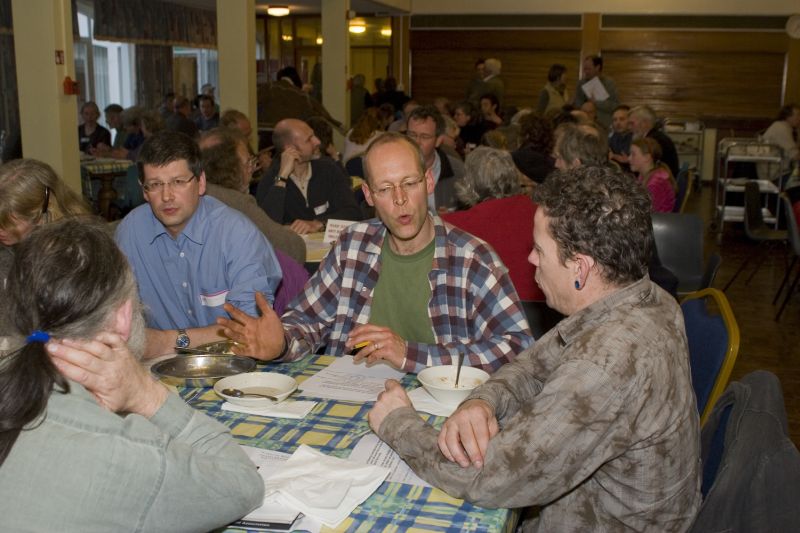20 Mar 2008
12 Tools for Transition: No.9. Designing Productive Meetings
 Very soon you will find that you are having meetings, and that you need to get a lot done in a limited amount of time. For most of us, the idea of meetings, indeed the very mention of the word, leads to a sinking feeling, akin to that associated
Very soon you will find that you are having meetings, and that you need to get a lot done in a limited amount of time. For most of us, the idea of meetings, indeed the very mention of the word, leads to a sinking feeling, akin to that associated
with the words “going to the dentist” and “doing your accounts”. One notable sustainability project that I followed for a while in the UK in the early 90s, folded after four years of innovative and productive work. I asked one of the founder members why. “I think we just met each other to death”, he told me. It doesn’t have to be like this. There are a number of tools that we use that make our meetings far more productive, and, dare I say, enjoyable.
‘Go-Rounds’
These are key in a meeting, and in TTT we usually use them in two ways. Firstly at the beginning of a meeting we do a go-round of what has been happening in each person’s group since the last meeting. We give each person 5-10 minutes,
and avoid interrupting them or getting into a discussion about what they have said. During their time they are also asked to begin with “how am I feeling right now”, and then, once they have updated the meeting on progress in their group, to highlight what they would like to be put on the agenda for the meeting.
In the group’s early meetings, when the people are still getting to know each other, we also put in a “throwaway question” for the end of each person’s time. These can be things like “the best meal I ever had”, “the most beautiful place I have ever been”, or “the greatest piece of music I ever heard”. There are of course many variations on this, but they enable the group to get to know each other a bit better, and to relax more with each other.
Open Agendas
We don’t prepare an agenda in advance. The danger with prepared agendas is that there is a sense that somewhere ‘they’ have set the agenda for the meeting and have decided in advance what will be discussed and even what will be decided. It is centrally important that any sense of this kind of hijacking of the group’s intentions is overcome. We start the meeting with a blank sheet of flip-chart paper, and as we do the introductory go-round, we write up the issues and questions that people want to see put on the agenda. Once this list is complete, we collectively go through the list and label each item between one and three, one being “this must be discussed today”, two being “ideally we’d like to talk about it today, but at a push it can wait”, and three being “this could wait until next time”.
We then assess how much time we have left in the meeting and allocate each item a time limit, which we then try to stick to religiously. It is a good idea to also timetable the rest of the meeting so that at the end you close with a noncontentious
issue, so that you don’t all leave seething with each other! It is important to keep the agenda visible to all, and to check with everyone that the item has been satisfactorily dealt with before it can be checked off the list.
‘Think and Listen’
These have been explained in detail above, but they can also be useful in meetings when you want to take a short break from addressing a big issue, and give people the space to order their thoughts in advance of tackling it. It is also a useful tool for keeping people’s brains alive – halfway through a meeting eyelids can occasionally start to become heavy, and a ‘Think and Listen’ can be quite an energising and refocusing tool to use at that point.
Clear Beginnings and Endings
Make sure the meeting starts with something to mark its opening, perhaps a minute of silent reflection, or even just announcing that the meeting has begun. At the end, it is good to have something that formally closes the meeting, so that it feels like it has a formal sense of closure, rather than just drifting off into the next thing.
Celebration!
Again, this is a key component of your meetings. One of the easiest and most satisfying ways of doing this is to eat together. At TTT meetings, we all bring a dish to share and end our meetings by having lunch together. As well as satisfying the need for food, it also addresses a longer-term need for getting to know each other better in a non-meeting context.
The Layout of a Typical Transition Town Totnes Project Support Group meeting • Welcome
• Go-round in which each person has five minutes, uninterrupted, to talk about everything that is happening in the group that they facilitate.
• We then brainstorm what people would like to be on the Agenda for the meeting.
• Go through that list and prioritise items, dismiss those that can wait until the next meeting, deal with those that require simple answer or brief agreement, then allocate time to the discussion of each remaining subject.
• At the end, arrange date for the next meeting, then eat together for the last hour, to discuss any other issues and to build our ‘social glue’.